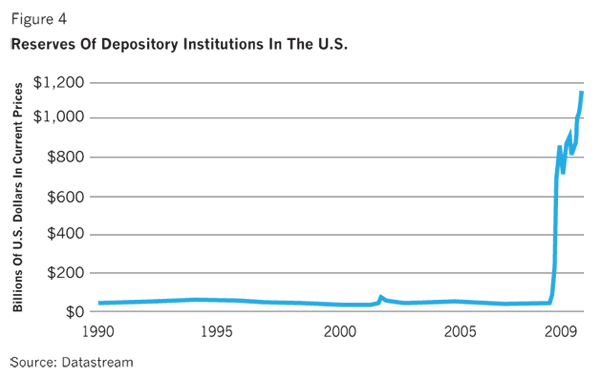
Although the Fed has indicated its desire to keep inflation at bay, investors have expressed concern that it might be slow to reduce the monetary base given its mandate to simultaneously strive for stable prices and full employment.4 The question is whether the Fed will be sufficiently hawkish on inflation to begin raising rates and draining liquidity on the first signs of significant inflation, even if it occurs in a high unemployment environment. This is a valid concern, especially as long as the Fed also perceives a risk of potential deflation (for example, deflation risk might stem from a double dip in the housing market, commercial real estate, or other asset-backed market). Deflation is generally perceived by the Fed as a worse outcome than inflation at similar magnitudes, which might lead the Fed to err toward modest increases in inflation. Perhaps it goes without saying, but the Fed failing to drain liquidity in a timely manner once there are early signs of inflation could result in a cycle of higher inflation expectations and subsequently increasing inflation realizations, a state of the world the Fed has claimed it wishes to avoid.
Will the Fed Inflate Debt Away?
In addition to concern about the Fed's monetary stimulus, investors are also justifiably focused on dramatic budget deficits and increasing debt levels. They fear these deficits may provide incentive for the government to "inflate its debt away" by lowering the real value of future debt repayments. However, this concern seemingly fails to recognize that the Fed is run as an independent Board of Governors and merely reports to Congress on its policies and procedures (though cynicism about the degree of its independence is one contributor to potentially higher inflation expectations). The importance of having an independent monetary authority is well understood in the U.S. and around the world. As long as the Fed has independence over monetary policy decisions, it will likely try to maintain relative price stability. If there is a concern about monetizing the debt, it should be evaluated based on the probability that the Fed will be stripped of its independence (oddly, the goal of many Fed cynics). Even within the current political environment we believe this is a low-probability outcome.
In summary, while we have experienced an unprecedented monetary stimulus in the U.S. economy, we have not yet seen a significant increase in realized inflation or in money supply, a leading indicator of future inflation levels. And though there is good reason to question whether we may face higher levels of inflation in the future, we do not believe that current economic indicators provide a clear case for a significant increase in the near term.
Is Inflation "Priced In" to Certain Assets?
Many market participants point to the breakeven rate, the difference between the yield of nominal and inflation-linked bonds, as the market expectation of inflation. Although breakeven rates are indeed correlated with inflation expectations, they contain an additional, and often overlooked, cost - the inflation risk premium. In much the same way as a policy holder must pay to insure one's property,5 the inflation risk premium is the premium a holder of an inflation-protected asset must "pay" (or more accurately forego) for the protection itself.6
The inflation risk premium is only one of the factors that affect the returns from holding inflation sensitive instruments. In the discussion that follows, we describe these factors for nominal and inflation-linked government bonds (TIPS in the U.S.), since these assets are directly comparable and are inversely affected by inflation. The following factors are the primary components which may determine the yield of these government bonds above the risk-free rate (excess yield):
1. "Real" Term Premium - compensation for the risk associated with holding a longer-term bond and taking the risk of real rates moving
2. Inflation Expectation - compensation for expected rise in prices
3. Inflation Risk Premium - compensation for assuming the risk of changing inflation (inflation uncertainty)
4. Liquidity Premium - compensation for holding an asset that is harder to trade during adverse environments
There are essentially two sources of risk that nominal and inflation-linked bonds do not have in common: inflation and liquidity. The inflation risk premium is compensation that nominal bond holders expect to receive since they accept inflation risk relative to holding inflation-linked bonds. However, inflation-linked bonds are generally less liquid than nominal bonds on the secondary market due to the dramatic difference in market depth. As of December 31, 2009, the total amount of outstanding U.S. nominal treasury securities held by the public was $7.3 trillion. In contrast, the size of the TIPS market was only $560 billion (less than 8% of the nominal market size).7 Holders of inflation-linked bonds are exposed to liquidity risk and in general expect to be compensated for taking this risk relative to holding nominal bonds. This liquidity effect puts upward pressure on inflation-linked bond yields (downward pressure on prices) and vice-versa for nominal bonds. Over time, as we expect the size and depth of the TIPS market in the U.S. will continue to increase, the liquidity effects should diminish, resulting in the inflation breakeven rate between nominal bonds and TIPS serving as a more accurate indication of inflation expectations and the inflation risk premium. Figure 5 presents the direction of the risk premia and inflation expectation effects on inflation-linked and nominal government bond yields, as well as the effect on breakeven rates (Nominal - TIPS).
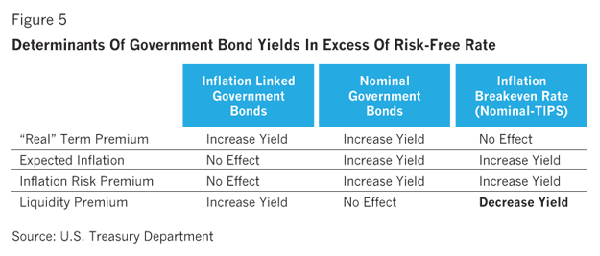
One important clarification is in order. If the inflation rate an investor is concerned with is accurately represented by CPI, inflation-linked bonds held to maturity are effectively the risk-free asset (though a higher real return may be achievable by holding nominal government bonds). However, although the real yield on an inflation-linked bond is known in advance and is not exposed to inflation risk, the bond may still, in practical terms, be "risky" for an investor who may need to sell it prior to maturity. This is due to mark-to-market pricing risk if inflation expectations and/or the magnitude of the real term or liquidity premia have changed.
Before using breakeven rates to infer future expected inflation rates, it is important to note the effect that the inflation and liquidity risk premia have on the breakeven rate. In times of heightened uncertainty, the inflation risk premium can significantly increase as there is heightened demand for inflation protection. This effect increases the relative price of inflation protection but is not actually forecasting higher future inflation. As mentioned above, there is also a positive liquidity premium to holding inflation-linked bonds which tends to decrease breakeven rates. Given high levels of inflation uncertainty - an environment we may currently be in - the inflation risk premium is higher than average, which signals that buying nominal bonds is cheaper than average. It also follows that the opportunity cost of holding inflation-linked bonds versus nominal bonds is higher than average (since investors forego potentially higher yields of nominal bonds). In other words, TIPS may have lower yields than normal versus nominal bonds not because the market is forecasting high inflation, but because the market is willing to pay more than usual to hedge the possibility of higher inflation.
The magnitude of the inflation risk premium effect on assets can be significant over the long term. To illustrate the relative importance of the premium, we compare the hypothetical8 long-term excess return from holding inflation-linked bonds vs. simply holding nominal bonds, each with similar duration to that of 10 year bonds. The average outperformance of nominal bonds vs. inflation-linked bonds can be thought of as the net ex-post "cost" of buying inflation protection. The ex-post cost is a function of both varying risk premia and ex-post inflation realizations which differ from what was priced in. Inflation surprises which exceed priced-in expectations favor inflation-linked bonds (holding other factors constant).
Since inflation-linked bonds were not introduced in the U.S. until the late 1990's, we can examine United Kingdom inflation-linked bonds (introduced in 1981) to gather the most data points. During this period, the average annual total return was 5.6% on a U.K. nominal bond and 3.5% for a U.K. inflation-linked bond.9 Hence the "cost" of inflation protection net of liquidity concerns was 2.1% in annual returns. This cost was due in part to a surprising decline in inflation during the early 1980's (a realization lower than priced-in expectations) and in part to the inflation risk premium which favors nominal bonds. Therefore, the effective realized cost of inflation protection for a U.K. investor holding a fixed duration inflation-linked bond portfolio was 60% of its total return. Performing the same analysis in the U.S. from 1997 (when TIPS were first introduced), the cost of inflation protection has been 0.8% per year. Most academic studies seeking to quantify the magnitude of the inflation risk premium estimate it at approximately 0.5% annually for a 10-year nominal bond.10 Of course, actual realizations of inflation which differ from market expectations will determine the final cost or benefit from holding inflation-linked versus nominal bonds net of risk premia effects.
Year-end U.S. breakeven rates (including both inflation risk and liquidity risk premia) for U.S. inflation over both the short- and long-term can be seen in Figure 6 and 7. Figure 6 shows the one-year breakeven and economists' forecasted one-year U.S. inflation rate as reported by Consensus Economics. Of course, both TIPS and nominal bonds are offered at different maturities, implying different breakeven inflation rates at each maturity. Figure 7 shows the term structure of breakeven rates for the U.S., which incorporates longer-term breakeven rates.11
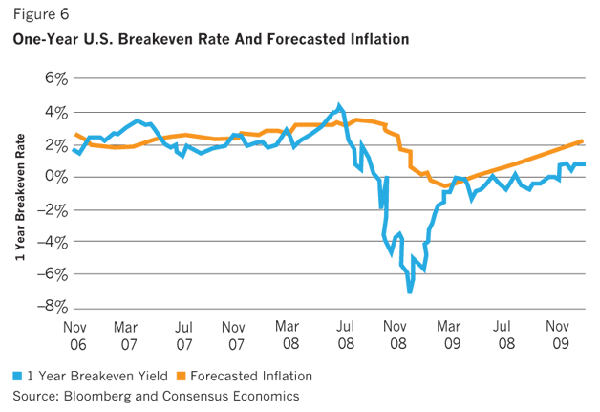
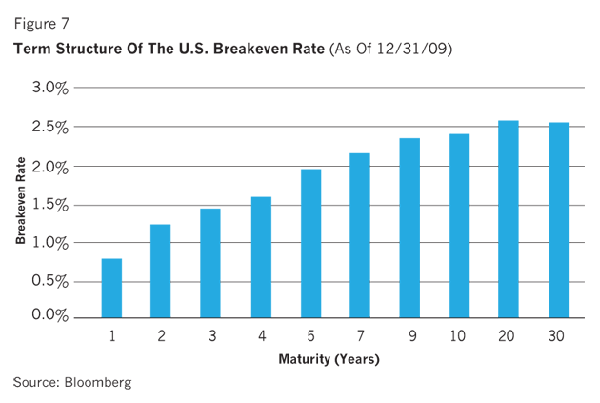
Although Figure 7 suggests moderate inflation expectations even over longer horizons, it is important to note that the breakeven rate is not simply a prediction of future inflation. Rather, as outlined previously in Figure 5, the inflation breakeven rate is also affected by the inflation risk premium (which increases the rate) and the liquidity premium (which decreases the rate). Depending on the market environment, the relative magnitude of each factor will vary and lead to divergence of breakeven rates from expected inflation. Nevertheless, a number of striking facts are observable in Figures 6 and 7. First, despite the discussion about inflation uncertainty (and fear of longer-term inflation), breakeven rates are moderate over most horizons. That can be a result of moderate inflation expectations, a low inflation-risk premium or a high liquidity premium associated with nominal bonds. Second, if we accept the inflation forecasts from Consensus Economics as the expected outcome, one-year TIPS may be attractively priced as of 12/31/09 (meaning that inflation expectations are higher than the breakeven rate). Of course, the Consensus Economics forecast may differ substantially from inflation realizations. Inflation surveys from the Survey of Professional Forecasters12 that provide longer-term forecasts for U.S. inflation show that inflation expectations approximately match the average 2.4% priced into the term structure of breakeven rates reflected in Figure 7, suggesting expected inflation is fully "priced in" over this period.
While the level of future expected inflation priced into the market may be modest, there are indications that the uncertainty around the market's estimates has increased, which implies greater demand for inflation protection and higher expected returns on nominal bonds relative to TIPS. Figure 8 shows the 10-year inflation forecasts from the Survey of Professional Forecasters with a confidence bound around it and a measure of dispersion in the forecasts. Although there is little evidence of a change in the average 10-year inflation forecast, there is indeed an increase in the dispersion of forecasts which suggests heightened uncertainty. This implies a higher inflation-risk premium today than on average (lowering the expected return from holding inflation-linked bonds).
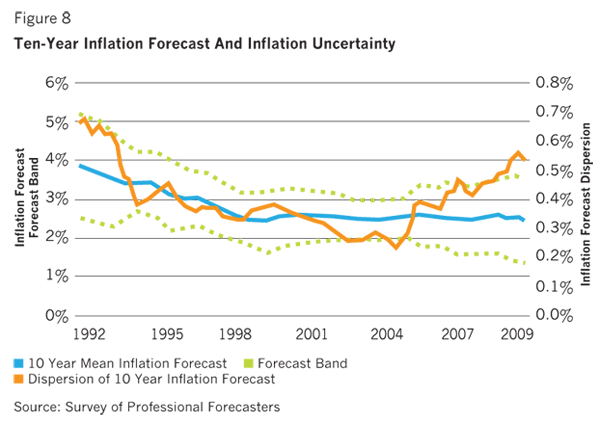
Inflation Protection in a Portfolio
Although the scope of this paper is only to outline the key considerations related to inflation and inflation-protected assets, it is important to reiterate that what matters most to the performance of various asset classes is not the level of future inflation, but rather the unexpected level of realized inflation. Simply stated, if the market price for goods and services reflects the average or consensus view for potential future inflation, only a deviation from the consensus will lead to value gained - or lost - by holding inflation sensitive assets. In Part II of this series we will build upon these insights and examine the strategic case for inflation-protected assets in portfolio construction and the performance of various asset classes in different inflation and economic environments.
Footnotes:
1 Monetary base is currency in circulation and bank reserves deposited with the Fed. Money supply (M2) includes all liquid money including checking and saving accounts, money market accounts and certificate of deposit under $100,000.
2 Unemployment is often said to underestimate the "under-employed" rate - or the rate including those who are working part-time because they cannot find full-time work and those who have given up looking for work. Some economists estimate the under-employed rate at over 17% in the U.S.
3 Inflation expectations are a key factor monitored closely by central banks. Inflation is one of the factors that exhibit "self fulfilling expectations." For example, if employees expect inflation to be high they are likely to demand wage increases which leads to inflation. Adjusting inflation expectations downward when inflation is high can be very costly as experienced during the Paul Volker years at the Fed. The Fed would want to avoid this cost of bringing inflation expectations down in the future.
4 The fed has two mandates: price stability and full employment. This is the often mentioned "Dual Mandate".
5 The actual premium that a home owner pays includes an expected loss and an additional premium for passing the risk to the insurer. This additional premium is what we refer to here as the cost of insurance, not the out-of-pocket payment to the insurance company.
6 Another interpretation of the inflation risk premium is that it is the compensation nominal asset holders require to bear inflation risk.
7 Source: U.S. Treasury Department
8 Hypothetical performance is for illustrative purposes only and is not based on an actual portfolio being traded.
9 Source: Barclays Capital. The statistics are calculated over the period April 1982 through December 2009.
10 Source: Barclays Capital, based on a set of rolling bonds over the period March 1997 through December 2009.
11 Consensus Economics surveys multiple professional forecasters including banks' economists, private and public forecasting services, and large financial institutions. In the U.S. as of the end of 2009, this includes 26 individual institutions.
12 The Survey of Professional Forecasters is the oldest quarterly survey of macroeconomic forecasts in the United States. The survey began in 1968 and was conducted by the American Statistical Association and the National Bureau of Economic Research. The Federal Reserve Bank of Philadelphia took over the survey in 1990.
Michael Katz, PhD, and Christopher Palazzolo, CFA, are vice presidents at AQR Capital Management.








